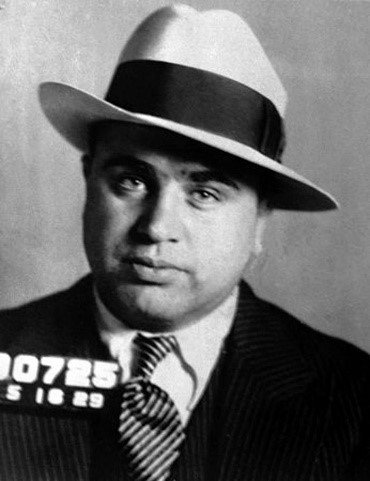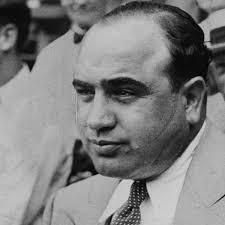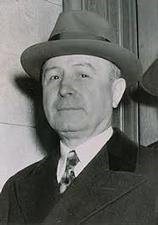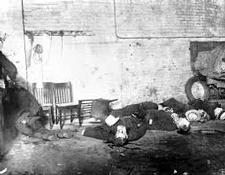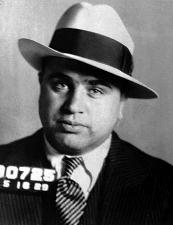Chicago in the 1920s. Jazz is playing, illegal booze is flowing, palms are being greased and rival gangs are mowing each other down in the streets. At the centre of it all is a larger than life character whose carefully cultivated image as a cheerful businessman disguises an incredibly violent streak. Equally calculating and hot-tempered, personable and vicious, he has worked his way up the ladder of organised crime to become the undisputed boss of the criminal underworld and, in many ways, the de facto leader of the entire city. His name is Alphonse ‘Al’ Capone, and even in the modern day he remains perhaps the most infamous of all the mafia bosses who enjoyed their heyday in the ‘roaring ‘20s’.
This is no accident. The son of poor Italian immigrants, Capone ensured that he enjoyed his life at the top and basked in the luxury that his ill-gotten wealth afforded him. While other mob bosses favoured a low-profile, he bathed himself in media attention and made sure he was one of the most well-known faces in the country. Presenting himself as a concerned businessman who wanted the best for his fellow Chicagoans, he received generous press coverage and adulation from many people, but no amount of favourable press could cover up the darker side of his life. However much he played the media – and he truly was a celebrity in his day – the fact remained that Capone was a cold-blooded killer, a gangster to his bones.
Born in Brooklyn
A knife attack in his youth earned Capone the nickname 'Scarface.'
Alphonse Capone was born on January 17th, 1899, in Brooklyn, New York. He was the fourth of nine children born to Italian parents, Gabriele and Teresa, who had immigrated from Naples in 1893. The Capones lived near the Brooklyn Navy yard which was home to many bars and brothels frequented by sailors, but the family always stayed on the right side of the law and Al was by no means destined to become a criminal. However, his short temper was always apparent, and according to biography.com he was expelled from school at the age of 14 for hitting a teacher who he felt had disrespected him. Al would never go back to school, instead spending the rest of his teens working odd jobs and becoming increasingly involved with the predominantly Italian-American gangs that had been formed across Brooklyn. One of these gangs was led by Johnny Torrio, who was to become Al’s mentor and facilitate his eventual move to Chicago.
At the age of 16, Capone became a fully-fledged member of the Five Points gang and worked as a bartender in a bar/brothel owned by one of the leaders, Frankie Yale. It was during a fight in the bar – one of many that Capone was involved in – that a local thug slashed him across the face with a knife, leaving an indelible mark on his cheek for the rest of his life. It would earn Capone the nickname ‘Scarface.’
By this time, the Capone family had moved to a more prosperous neighbourhood in Brooklyn. Gabriele, a barber, and Teresa, a seamstress, had managed to improve their condition through legitimate means, emphasising the fact that it was not as if young Al had no choice but to be a criminal. Indeed, his parents did not approve of the local gangs and encouraged their children to find honest work. It was in the more prosperous neighbourhood that Al met Mary ‘Mae’ Coughlin, the daughter of a middle-class Irish family. Mae gave birth to their son, Albert Francis Capone, in 1918 and the couple married a few weeks later. Now that he was a husband and father, Al Capone decided to abandon his fledgling criminal career and moved to Baltimore, where he took up a job as bookkeeper for a construction company.
The year that changed Al Capone's life
Three events in 1920 changed the trajectory of Capone’s life. First, the 18th Amendment to the US Constitution – also known as the Volstead act – came into force, banning the sale and consumption of alcohol in the United States. Second, Gabriele Capone died of a heart attack. Third, Johnny Torrio, Al’s old mentor and godfather to his infant son, invited him to join a booming criminal business in Chicago. Freed from the disapproving frown of his father, a 21-year-old Al Capone jumped at the opportunity and moved to Chicago.
Johnny Torrio
Torrio was heavily involved in prostitution through the 1910s, one of the top deputies in ‘Big Jim’ Colosimo’s brothel empire. Torrio recognised how prohibition was a huge business opportunity – with alcohol no longer available by legal means, criminal gangs such as theirs would have a monopoly on the product – but Colosimo was reluctant to move into the business. He was shot and killed that year, with Torrio and Capone quickly moving to take control of his empire. No one was ever arrested for Colosimo’s murder, but all evidence points to Torrio and Capone being heavily involved.
Torrio’s Partner
The illegal production, transportation and sale of alcohol was known as ‘bootlegging’, and it secured huge profits for the gang. While Torrio was reserved and kept a low profile, Capone quickly developed a reputation as a big drinker who was always spoiling for a fight. He was arrested in 1923 for drunk driving and, although Torrio used his connections with corrupt city officials to bail him out of prison, it served as a wake-up call for Capone. The same year, his mother and some of his siblings also moved to Chicago, grounding Capone and allowing him to develop as a businessman rather than just a hard-drinking thug.
But Capone’s fighting instincts were not completely redundant. He and Torrio genuinely saw themselves as entrepreneurs but their trade was still illegal and keeping the law off their backs required intimidation as well as charm and bribery. Further, they were not the only gang in town. While Torrio and Capone headed a network of predominantly Italian American gangsters on Chicago’s south side, a predominantly Irish American gang headed by Dean O’Banion operated in the north side. There was an intense hostility between the gangs but Torrio, always preferring diplomacy to violence, refrained from ordering a hit on O’Banion.
The gang were forced to move the base of their operation to Cicero, a suburb of Chicago, after the city of Chicago itself elected a reformist Mayor in 1923 who promised to stamp out the rank corruption that allowed bootlegging gangs to operate with impunity. In 1924, a similar candidate ran as a Democrat to replace the Republican Mayor of Cicero, who was a Torrio puppet. Torrio and Capone orchestrated a campaign of voter suppression and on polling day, 1st April, Al and his older brother Frank led a gang of thugs to intimidate Democrat voters. By the afternoon, the Chicago police were sent to disperse the thugs and Frank Capone was killed in the ensuing shootout. Frank had been a calming influence on Al, and without him Al would indulge his wilder side in the years to come.
The following month, Johnny Torrio met Dean O’Banion at dawn one morning at a brewery that O’Banion was handing over to him. Torrio signed the contract and handed him the $250,000 fee, but moments later both leaders and their accomplices were arrested in a police raid. Since Torrio had signed the contract before his arrest, he was now facing charges of operating an illegal brewery, while O’Banion got away with his money and no criminal charges. Feeling he had been played, he finally gave consent for the hit on O’Banion. He was duly murdered on the morning of 10th November 1924, but Torrio’s initial instinct to refrain from killing him had been correct – the incident sparked a brutal war between the two gangs that would last five years.
Replacing Torrio
The northside gang, now led by Hymie Weiss and George ‘Bugs’ Moran, sought revenge for O’Banion’s death and in 1925 made an attempt on Johnny Torrio’s life. Torrio survived the assassination effort but resigned his leadership of the gang, retiring back to Italy after serving a nine-month prison sentence for operating the illegal brewery. He handed full control of the gang to Al Capone.
Torrio had always sought to work in the shadows and avoid media scrutiny, but for the rest of the 1920s Al Capone was the most visible gangster in the country. He boldly moved his headquarters to a plush suite in the Metropole hotel in downtown Chicago and paraded his luxurious lifestyle in front of the cameras. He always dressed in a pristine suit, he was chauffeured in a $30,000 armour-plated car and was seen at operas and parties with Chicago’s elite. He worked with the media to make sure that he received positive coverage, and they gave gushing details of his acts of generosity for struggling families and communities. With prohibition becoming increasingly unpopular, Capone was seen as a ‘man of the people’ figure whose only crime was to provide the public with what they wanted. Using his connections in New York he started to develop a lucrative trade in whiskey and, combined with the money he made from running brothels and gambling joints, his net worth in 1927 was estimated at an astronomical $100 million.
However, Capone could not distance himself from the violent turf wars that were gripping the city. In 1926, he ordered a hit on two of his enemies who had been spotted in Cicero, not realising that they were travelling with a public prosecutor, William McSwiggin. The prosecutor was killed and the public outcry forced Capone to go into hiding for three months. He remained above reproach for now, but ambitious lawmen knew that they could make a name for themselves if they managed to take him down. While Capone was back to flaunting his lifestyle by 1927, his days were already numbered. Authorities were painstakingly building a case against him.
Fall from grace
The aftermath of the St. Valentine's day massacre
Ironically, it was perhaps Capone’s greatest triumph in his gang wars that would hasten his downfall. Aware that Bugs Moran had ordered a hit on him, he plotted a move that would permanently get rid of the north side threat. At around 10:30 on the freezing cold morning of 14th February 1929, Capone’s men disguised themselves as policemen and staged an arrest at a garage owned by Moran. Moran’s men complied with the order to hand over their guns, but they were not especially worried – after all, this was not the first time they had been shaken down by police. They lined up with their faces to the wall expecting, at the very worst, to be arrested and eventually bailed out by their boss, but Capone’s men savagely opened fire with machine guns and all but one of the seven north siders were dead before they even knew what was happening. The seventh victim, a man named Frank Gusenberg, died minutes after the real police arrived on the scene. The incident became known as the St. Valentine's day massacre.
Al Capone had made sure he was on holiday in Florida when the massacre occurred and was surely elated when he received word the deed had been done, but his elation would not last. This was firstly because Bugs Moran himself had not entered the garage after seeing the police car parked outside, and thus had escaped with his life. Secondly, although Capone thought he had the perfect alibi, he quickly realised that no one in the country doubted for a second that he had orchestrated the murders. The manner of the murders was so shocking that even his friends in the media would not protect him, and he was forced to sheepishly return to Chicago professing his innocence to a disbelieving and enraged public. The massacre also attracted the attention of President Herbert Hoover, who demanded that federal prosecutors bring Capone to justice. Within a year, he was sent to prison for nine months for being caught in possession of a concealed weapon, although it is probable that Capone organised this arrest with other mob bosses during a meeting in Atlantic City in which they agreed he needed time out of the spotlight. The sentence was light, but it was a sign that the net was closing in on Al Capone.
Upon his release he tried to resume his opulent lifestyle, but he found the nation in a very different mood to when he had first been sent to prison. In October 1929 the stock market, which had seen unprecedented growth over the previous decade, crashed spectacularly and sent the wider economy into a tailspin. Wages were falling, unemployment was rising, and the carnival that had been the ‘roaring ‘20s’ was over. This was particularly the case for Capone, who’s destruction would be sealed in the new decade.
A mugshot of Capone
On 5th June 1931, Al Capone was indicted on tax evasion charges. The government knew that they would never be able to pin his more egregious crimes on him because to do so would require witnesses, who could easily be intimidated or bribed by his gang. Instead, they used Capone’s lavish lifestyle against him, forcing him to try and explain why he had paid such a little amount of taxes when he clearly had such a huge income. Still, Capone’s situation did not appear desperate. He struck a deal with prosecutors where he would plead guilty and receive less than five years in prison, but the judge threw the agreement out. Capone then pled not guilty, and fully expected to be acquitted because he had his cronies work the jury with the usual routine of threats and bribes. However, at the last moment the judge replaced the entire jury, and Capone was left helpless as he was convicted and sentenced to 11 years in federal prison. Stunned, he was led away from court, and from his life at the top, in shackles.
Final days
Capone spent the first two years of his sentence in Georgia, but after it was discovered that he had made numerous attempts to bribe the guards there he was transferred to the recently opened Alcatraz prison, perched on a rock in the middle of the San Francisco bay. It was here that his health would rapidly decline. His frequent use of prostitutes in his younger days started to catch up with him, as the syphilis he had contracted developed and became incurable. By 1939, doctors discerned that Capone had the mental capability of a 12-year-old, and he was sent to a hospital in Baltimore to serve out the rest of his sentence. Released in 1942, he lived in Miami with his wife Mae before finally dying on 25th January 1947, having just turned 48.
When news of his death spread it made front page news, but he was quickly forgotten. By the time of his death he had not been in the headlines for over 15 years. Prohibition had been repealed in 1933 and the bootlegging anti-heroes of the 1920s were replaced by bank robbing anti-heroes like John Dillinger and Bonnie and Clyde in the 1930s, and then by the real heroes of the war effort in the 1940s. The world had simply carried on without Al Capone. In his heyday he had been loved and feared, but in the modern day he is remembered for what he was – colourful, for sure, but a murderous gangster all the same.
More importantly, Capone serves as an example of what not to do as a crime boss. At the end of the 20th century, figures like John Gotti and Pablo Escobar followed the Capone playbook of flaunting their wealth and celebrity while indulging their violent impulses, and found that it only put huge targets on their backs. For all the glamour of his heyday, Capone was ultimately not a successful gangster.
Acknowledgements
The Ministry of History is not an academic source. Our pieces are written by writers who have been studying history for years and are well versed in and influenced by countless other writers and works. For this article specifically our sources have included:
'Al Capone' - article by mobmuseum.org
'Al Capone - Movies, Quotes and Son' - article by biography.com
'Al Capone - Scarface, Alcatraz and Death' - article by history.com
